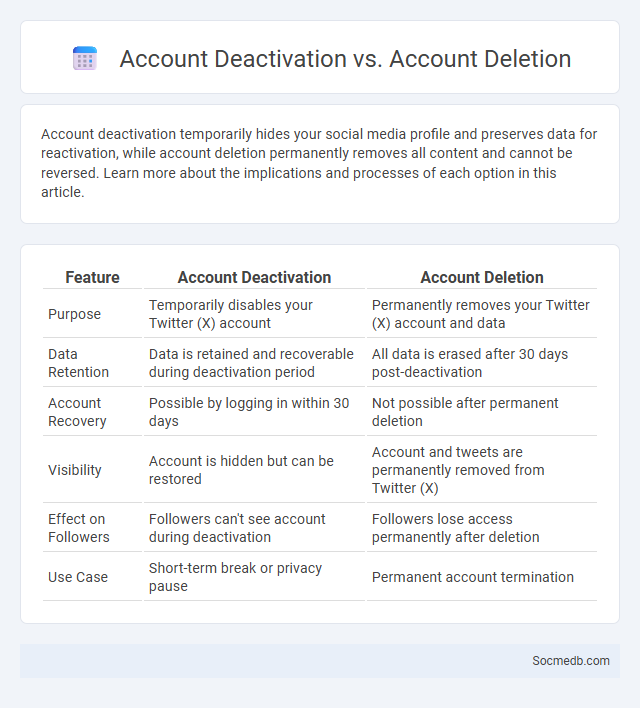
Photo illustration: Account Deactivation vs Account Deletion
Account deactivation temporarily hides your social media profile and preserves data for reactivation, while account deletion permanently removes all content and cannot be reversed. Learn more about the implications and processes of each option in this article.
Table of Comparison
| Feature | Account Deactivation | Account Deletion |
|---|---|---|
| Purpose | Temporarily disables your Twitter (X) account | Permanently removes your Twitter (X) account and data |
| Data Retention | Data is retained and recoverable during deactivation period | All data is erased after 30 days post-deactivation |
| Account Recovery | Possible by logging in within 30 days | Not possible after permanent deletion |
| Visibility | Account is hidden but can be restored | Account and tweets are permanently removed from Twitter (X) |
| Effect on Followers | Followers can't see account during deactivation | Followers lose access permanently after deletion |
| Use Case | Short-term break or privacy pause | Permanent account termination |
Introduction to Account Management Options
Managing your social media accounts effectively involves exploring various account management options tailored to your needs. Platforms like Facebook, Instagram, and Twitter offer settings such as personal profiles, business accounts, and creator profiles that optimize content sharing and audience engagement. Understanding these options enhances your ability to control privacy, analytics, and advertising tools for improved online presence.
Defining Account Deactivation
Account deactivation on social media temporarily disables your profile, hiding your content and making your presence invisible to other users without permanently deleting your data. This option allows you to pause your activity while retaining the ability to reactivate your account and recover your information at any time. Understanding account deactivation helps you manage your online visibility without losing important connections or content.
What is Account Deletion?
Account deletion on social media refers to the permanent removal of a user's profile, content, and associated data from the platform's servers. This process erases personal information, posts, messages, and connections, ensuring that the user's digital footprint is eliminated and cannot be recovered. Most social media sites provide account deletion options within their privacy or security settings, often requiring confirmation to prevent accidental loss.
Differences Between Deactivation and Deletion
Social media accounts can be either deactivated or deleted, each serving distinct purposes and effects on your data and visibility. Deactivation temporarily disables your profile, hiding it from other users but preserving your data for potential reactivation, whereas deletion permanently removes your account and all associated information from the platform's servers. Understanding these differences helps you make informed decisions about managing your online presence while protecting your privacy and digital footprint.
Temporary vs Permanent Actions
Temporary social media actions, such as Stories on Instagram or Facebook, vanish after 24 hours, creating urgency and exclusive content engagement. Permanent actions include posts, comments, and profile updates that remain visible indefinitely, contributing to long-term brand identity and searchability. Balancing temporary and permanent content maximizes audience interaction while preserving a consistent online presence.
Impact on User Data and Privacy
Social media platforms collect vast amounts of personal data, which can be used for targeted advertising and behavioral analysis, often without explicit user consent. This data harvesting increases the risk of privacy breaches, identity theft, and unauthorized data sharing with third parties. You must stay informed about privacy settings and data usage policies to protect your personal information from misuse.
Recovery Options: Can You Restore Your Account?
Social media platforms offer various recovery options to restore accounts compromised by hacking, password loss, or security breaches. Users can typically reset passwords via email or phone verification, use two-factor authentication (2FA) for added security, and contact support teams for identity verification in case standard methods fail. Understanding platform-specific recovery tools ensures swift regain of access and protection against future account suspensions or unauthorized access.
Platform-Specific Policies and Procedures
Platform-specific policies and procedures govern content guidelines, user behavior, and data privacy on each social media site to ensure compliance and safety. Understanding these unique rules helps you navigate platform restrictions, avoid account suspension, and tailor content for maximum engagement. Adhering to the terms of service and community standards is essential for maintaining your online presence and credibility.
When to Choose Deactivation Over Deletion
Deactivating a social media account is ideal when you want a temporary break without losing your data, allowing you to reactivate and restore your profile later. Choosing deactivation over deletion preserves your posts, photos, and friend lists, making it suitable for users uncertain about permanently leaving the platform. If privacy concerns or digital detox are temporary priorities, deactivation provides a reversible solution while deletion permanently removes all data and connections from the network.
Best Practices for Secure Account Management
Strong, unique passwords combined with two-factor authentication significantly enhance social media account security by preventing unauthorized access. Regularly reviewing account activity and updating privacy settings limit exposure to phishing and data breaches on platforms like Facebook, Instagram, and Twitter. Utilizing trusted password managers and enabling login alerts create proactive layers of defense against cyber threats targeting social media profiles.
 socmedb.com
socmedb.com